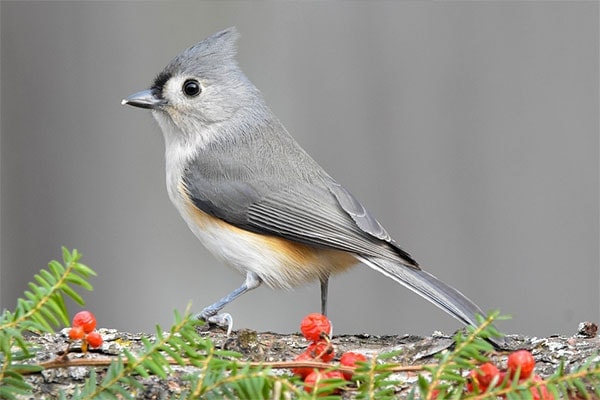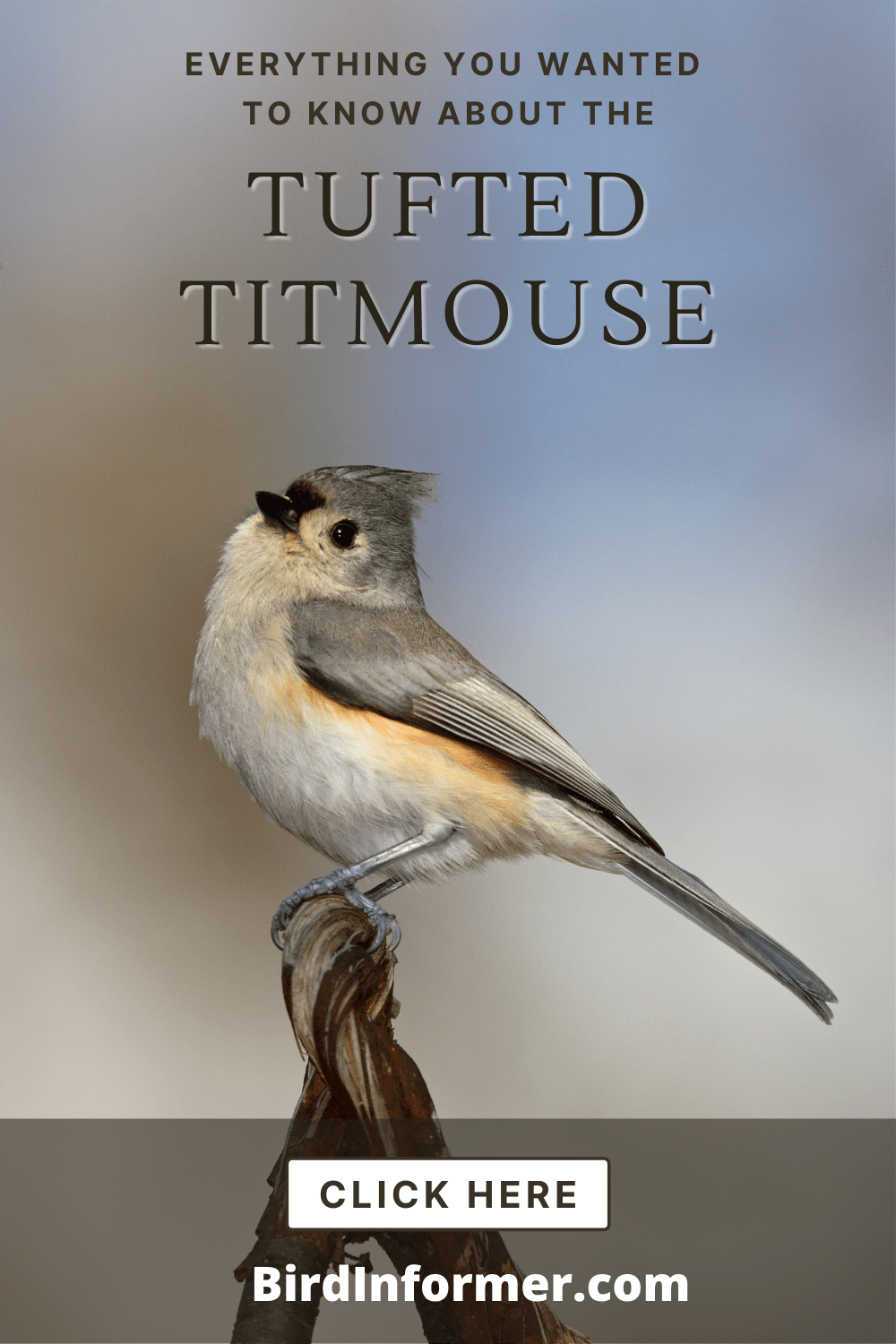Contents
- Tufted titmouse facts
- Tufted titmouse: how-to identify
- Tufted titmouse bird vocalization
- Where You’ll See A Tufted Titmouse
- Tufted titmouse diet
- Tufted titmouse nesting
- Tufted titmouse behavior
- How-to attract tufted titmice
- Tufted titmouse threats
- Tufted titmouse fun & interesting facts
- Tufted titmouse related species in this family
The Tufted Titmouse is a bold bird that will respond to your call. They are most common in the eastern forests, but they are frequent visitors of backyards. The birds feature a gray and white color pattern with a black area on their forehead. You will sometimes see them hanging upside down while foraging, looking for the biggest seeds despite their small size.
In this article, we are going to cover a wide variety of topics related to the Tufted Titmouse, such as:
- How to identify them
- How, when, and where they migrate
- Their diet
- How and where they nest
- And much more…
So, without any more delay…
Let’s jump right into it and learn more about the Tufted Titmouse.
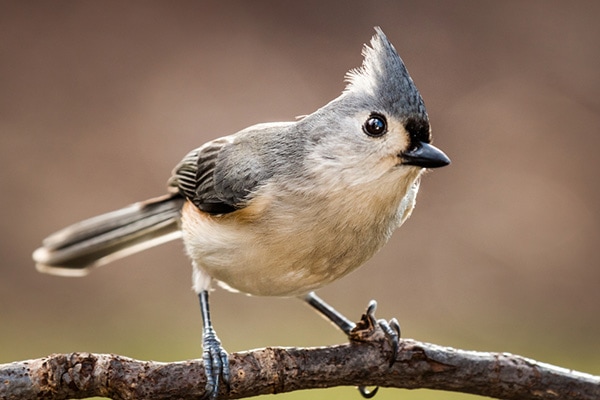
Tufted titmouse facts
- Common Name: Tufted Titmouse
- Scientific Name: Baeolophus bicolor
- Scientific Family: Paridae
- Life Span: 2.1 years
- Size: 5.5 to 6.3 inches
- Wingspan: 7.9 to 10.2 inches
- Weight: 0.6 to 0.9 oz
- Conservation status: Least Concern (LC)
Tufted titmouse: how-to identify
Tufted Titmice are small-sized birds that are about 4.5 to 5.5 inches long. These are full-bodied birds featuring large heads, large eyes, short bills, thick necks. The overall color pattern is gray and white.
The birds have this pointed gray crest on top of their heads, and there’s a black mark on their forehead, wings and back areas are gray, their underparts under white, and reddish-brown flanks.
Tufted titmouse male vs female
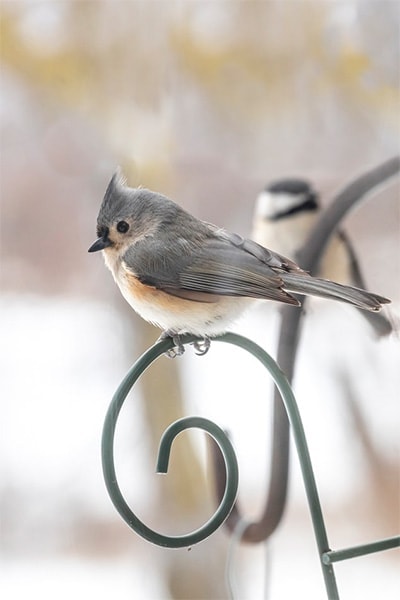
Here’s where it gets interesting – both males and females share a strikingly similar plumage. In fact, they’re so alike that it’s incredibly difficult to tell them apart based on looks alone. Both sexes sport the same gray upperparts and white underparts, with a white face and a black patch just above their bill. These birds flaunt a dash of peachy rust color on the flanks that really makes them pop.
The Tufted Titmouse’s almost identical look between genders is quite an anomaly in the bird world. Usually, males have more vibrant colors to attract females, but these Titmice seem to have shrugged off that trend.
| Characteristic | Differences Between Male & Female |
|---|---|
| Mating Behavior | During the mating season, which is typically from March through May, males engage in a songful display to woo the females. Their song is a loud and clear, whistle-like “peter-peter-peter”. Females, on the other hand, are often more quiet, but they can sing too! They usually only break into song in response to a male’s song or when they’re alone. |
| Nesting Behavior | Another clue can be found in their nesting behavior. The female is usually the one that selects the nest site and builds the nest. So, if you see a Tufted Titmouse carefully inspecting cavities or hauling nesting material, it’s likely a female. |
| Differences in Size | For the keen observers out there, there are minute differences in size and age between the sexes. Males are typically slightly larger than females, though this difference can be hard to spot in the wild. |
| Differences in Age | And here’s a titmouse tidbit that’s quite fascinating – females are often slightly older than their male counterparts in a mated pair. Why? It’s speculated that females need a little more time to mature and select a suitable mate. Quite the discerning ladies, aren’t they? |
While these birds might play a game of ‘twin’ with us birdwatchers, paying attention to their behaviors can offer us clues about their sex.
So, the next time you spot a Tufted Titmouse in your backyard or while you’re on a nature walk, remember there’s more than what meets the eye. With a little patience and observation, you might just crack the code to their gender mystery.
Differences In Summer Plumage vs Winter Plumage
Tufted Titmice have the same color pattern throughout the year, regardless if it’s the winter or summer season.
Tufted titmouse bird vocalization
Where You’ll See A Tufted Titmouse
Tufted Titmice are native bird species in the Nearctic region. They are found in the eastern part of the United States, east of the Great Plains, and southern Ontario. They stay in deciduous woodlands and sometimes in mixed evergreen-deciduous forests. As long as there are many trees, they’ll always find a home.
They are also frequent in parks, suburban areas, or even in orchards. They love visiting backyards and bird feeders.
Tufted titmouse bird migration
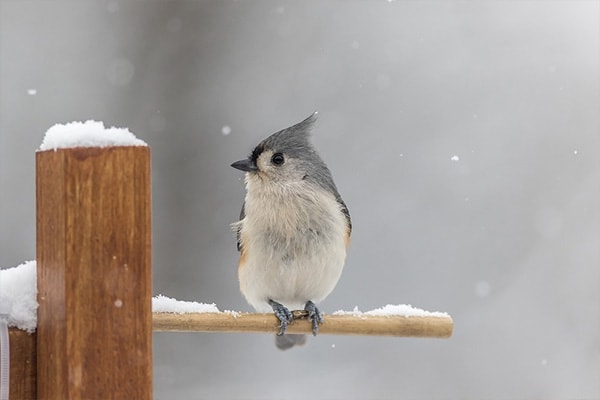
Tufted Titmice are permanent resident birds. So, you’ll likely find them in the same area every year, regardless of the season. Some birds may fly short distances, wandering northward to South Dakota, Quebec, Minnesota, and even into Southern Canada.
Tufted titmouse diet
Tufted Titmice are omnivores eating mainly insects and seeds. They eat insects a lot during the summer or the breeding season as they need a lot of energy. Caterpillars are essential to their diet, but they also eat bees, wasps, beetles, treehoppers, and spiders. Sometimes, they even eat snails.
When insects are not a lot during the winter season, Tufted Titmice will opt to feed on seeds, berries, and nuts such as acorns and beechnuts. The most interesting thing about these birds is that they would always choose the largest seeds when searching for food.
These birds would search for food on branches and twigs of trees, and sometimes you’ll even see them hanging upside down. Occasionally, they search on the ground or will visit bird feeders for more food.
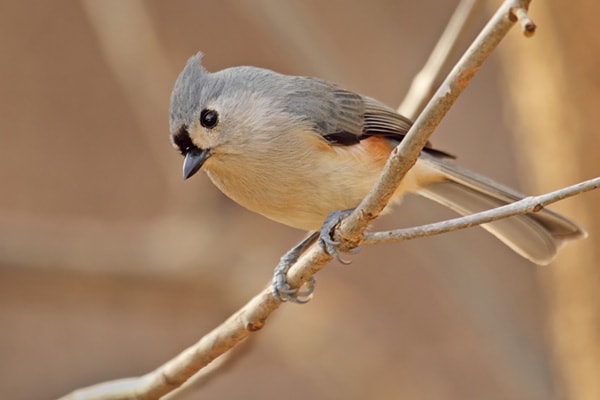
Tufted titmouse nesting
- Clutch Size: 3-9 eggs
- # of Broods: 1 brood
- Incubation Period: 12-14 days
- Nestling Period: 15-16 days
- Egg Description: White to creamy white, spotted with chestnut-red, brown, purple, or lilac
The breeding season starts between March and May. When pairs form, they usually stay together throughout the year. It’s the male birds that will bring food for the female until the eggs hatch. Some people also observed that the birds sometimes have helpers.
Tufted Titmice build their nests in cavities. However, since they don’t excavate, they will search for natural holes or old nest holes excavated by other bird species instead. There are also occasions when the birds nest on manmade structures like nest boxes or fence posts.
A cup-shaped nest is built using grass, moss, dried leaves, and barks as a foundation. Then it is lined with soft materials like animal hair and sometimes human hair. It usually takes 6-11 days to finish a nest.
Tufted titmouse behavior
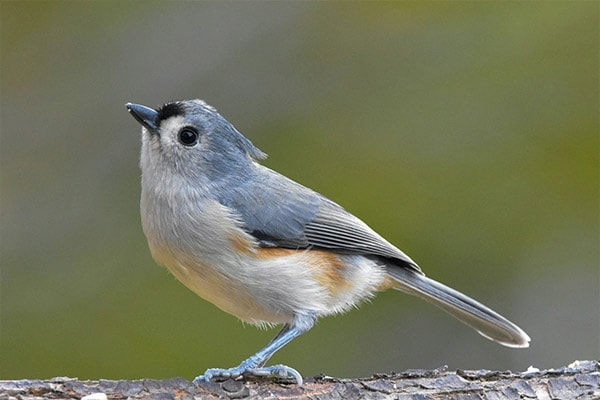
Tufted Titmice are very active birds, spending most of their day searching for food. They would be seen hopping on branches then moving from one tree to another to find something to eat. Sometimes, they would even hang upside down.
They are very interesting birds and sometimes respond to human voices calling to them. They love visiting bird feeders to get some food. They open nuts or seeds by holding them with their feet and hammering them with their beaks. When fall and winter seasons come, you’ll find them gathering food to eat and storing them under any objects on the ground.
Males are found to be more dominant, and pairs usually last until their mate dies.
How-to attract tufted titmice
Tufted Titmice are resident birds native only in the Nearctic region. So, if you’re within the area, know that these birds are one of the easiest to attract in your backyard. They are very bold and are confident enough to come close to humans calling to them.
If you plan to get them to visit your bird feeder, whether it’s summer or winter, you need to provide them their needs – food, nesting site, and shelter.
For bird feeders, only use the hopper feeder, platform feeder, tube feeder, or suet feeder. Then, fill these with sunflower seeds, peanuts, or mealworms.
To attract them better, plant some trees and shrubs that can provide the birds a shelter, nesting site, and more food. You can plant elderberry, beech, birch, maple, oak, and hickory. You can then place some nest boxes that these birds can use.
Lastly, provide water by having a birdbath installed.
Tufted titmouse threats
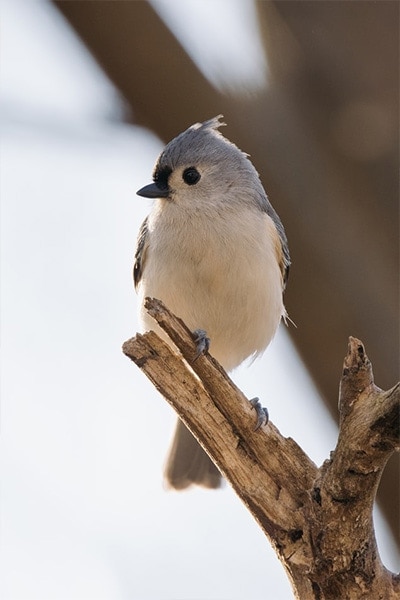
Tufted Titmice are very common birds with no significant population decline. As a matter of fact, the species range keeps expanding northward, probably because there are more habitats for them. Predators remain to be a significant threat to both nestlings and adult Tufted Titmice. Among their predators are hawks, owls, raccoons, snakes, skunks, squirrels, and cats.
Tufted titmouse fun & interesting facts
- The Tufted Titmouse bird call sounds like “peter-peter-peter”.
- These birds are found to store food under objects on the ground in fall and winter.
- They have short memories for their hiding spots; they don’t store food for future use as they will easily forget them.
- They use their feet to hold seeds while opening them.
- These birds can approach a human or an animal to pluck out hairs to use for their nests.
- The oldest recorded Tufted Titmouse was 13 years and 3 months old.
- Carolina Chickadee
- Black-capped Chickadee
- Mountain Chickadee
- Chestnut-backed Chickadee
- Boreal Chickadee
- Bridled Titmouse
- Oak Titmouse
- Juniper Titmouse
- Black-crested Titmouse

